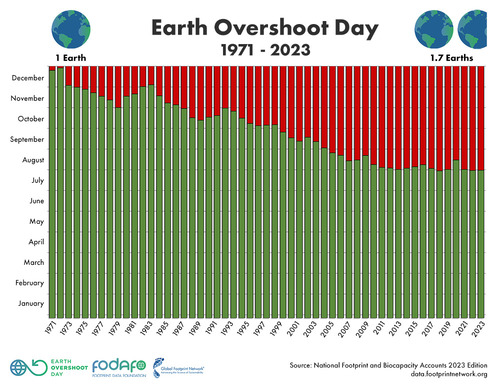Earth Overshoot Day is an annual event that marks the date when humanity’s demand for natural resources and ecological services surpasses the Earth’s ability to regenerate them within a given year. In other words, it’s the day when we have used up all the resources and services that the Earth can renew in that year, and from that point on, we are living beyond our planet’s means. Understanding your own Personal Earth Overshoot Day is a good way to bring some focus to your overall impact on the planet and helps to motivate you to make some positive changes.
The Global Footprint Network calculates Earth Overshoot Day each year by considering factors such as carbon emissions, food production, water consumption, and other resource usage. This year the date falls on the 2nd of August.
Unfortunately, the date has been getting earlier and earlier every year since they started measuring it. You can see this trend in the graph below (thanks to Overshootday.org).

Solutions for Earth Overshoot Day
The goal is to push Earth Overshoot Day later in the year or, ideally, to achieve a sustainable balance where human consumption remains within the Earth’s capacity.
What can you do to help push Earth Overshoot Day later and reduce our ecological footprint?
The following are meaningful actions you can take:
- Conserve Energy: Reduce energy consumption at home and work by using energy-efficient appliances, turning off lights and electronics when not in use, and opting for renewable energy sources whenever possible.
- Sustainable Transportation: Choose public transportation, carpooling, biking, or walking instead of driving alone to reduce carbon emissions and reliance on fossil fuels.
- Reduce Waste (My favorite!): Use what you have, buy less, and buy secondhand, choose products with minimal packaging and avoid single-use plastics and opt for reusable alternatives. Plus, do your best to reduce the impact of the waste you create by recycling or composting organic waste.
- Conscious Consumption: Make informed choices about the products you buy. Choose items made sustainably, from eco-friendly materials, and have a long-lasting design.
- Water Conservation: Conserve water at home by fixing leaks, using water-saving fixtures, and being mindful of water usage in daily activities.
- Support Sustainable Brands: Support companies and brands that prioritize sustainability and environmentally friendly practices. Take a look at our recycled products brand directory.
Individual actions, when combined, can have a significant impact in reducing our ecological footprint and moving Earth Overshoot Day later in the calendar year.
You can learn more about Earth Overshoot Day 2023 here.
Calculating Your Personal Earth Overshoot Day
Calculating your personal Earth Overshoot Day involves determining the date in the calendar year when your individual ecological footprint exceeds the Earth’s biocapacity to support your lifestyle. In other words, it’s an estimate of the date on which, if everyone lived as you do, humanity would exhaust the Earth’s resources and ecological capacity for the entire year.
To calculate your personal Earth Overshoot Day, you need to consider various factors that contribute to your ecological footprint, such as:
- Carbon Footprint: This includes the amount of carbon dioxide and other greenhouse gases emitted as a result of your energy consumption, transportation, and other activities.
- Food Footprint: This accounts for the land and resources required to produce the food you consume, as well as the associated transportation and waste.
- Housing Footprint: It takes into account the resources used in building and maintaining your home, including electricity, water, and other utilities.
- Goods and Services: The impact of the products you purchase and the services you use, including clothing, electronics, and other items.
- Waste Footprint: This considers the amount of waste you generate and its environmental impact.
- Water Footprint: The amount of water you consume and its impact on water resources.
To calculate your personal Earth Overshoot Day, you would compare your ecological footprint to the global biocapacity available. The Global Footprint Network provides a Footprint Calculator on its website, which allows individuals to estimate their ecological footprint and determine their personal Earth Overshoot Day based on their lifestyle choices.
Luckily there is a great online tool to help you calculate your ecological footprint and your personal earth overshoot day. Head over to Foot Print Calculator and find out what when personal earth overshoot day is and how many Earths we would need if everyone lived like you.
Earth Overshoot Day is a crucial reminder of our planet’s ecological challenges due to overconsumption and unsustainable practices. It highlights the urgency to reduce our ecological footprint, conserve resources, transition to renewable energy sources, and adopt more sustainable lifestyles.
Understanding your personal Earth Overshoot Day can raise awareness about the environmental impact of your lifestyle choices and encourage you to make more sustainable decisions to reduce your ecological footprint and move the date further away from the current global overshoot day.
Learn more about Earth Day and your impacts by checking out our recommended books for Earth Day.














